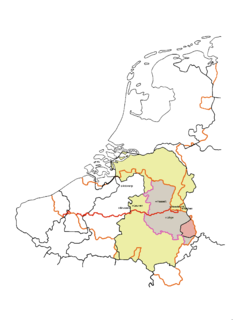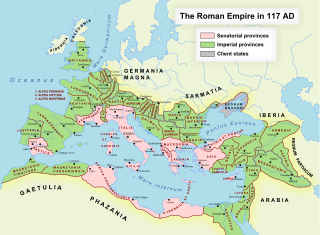 W
WThe Agri Decumates or Decumates Agri were a region of the Roman Empire's provinces of Germania Superior and Raetia; covering the Black Forest, Swabian Jura, and Franconian Jura areas between the Rhine, Main, and Danube rivers; in present southwestern Germany, including present Frankfurt, Stuttgart, Freiburg im Breisgau, and Weißenburg in Bayern. The only ancient reference to the name comes from Tacitus' book Germania. However the later geographer Claudius Ptolemy does mention "the desert of the Helvetians" in this area.
 W
WBarbaricum is a geographical name used by historical and archaeological experts to refer to the vast area of barbarian-occupied territory that lay, in Roman times, beyond the frontiers or limes of the Roman Empire in North, Central and South Eastern Europe, the "lands lying beyond Roman administrative control but nonetheless a part of the Roman world". During the Late Antiquity, it was the Latin name for those tribal territories not occupied by Rome that lay beyond the Rhine and the Danube : Ammianus Marcellinus used it, as did Eutropius. The earliest recorded mention appears to date to the early 3rd century.
 W
WThe borders of the Roman Empire, which fluctuated throughout the empire's history, were realised as a combination of military roads and linked forts, natural frontiers and man-made fortifications which separated the lands of the empire from the countries beyond.
 W
WThe Civitas Tungrorum was a large Roman administrative district dominating what is now eastern Belgium and the southern Netherlands. In the early days of the Roman Empire it was in the province of Gallia Belgica, but it later joined the neighbouring lower Rhine River border districts, within the province of Germania Inferior. Its capital was Aduatuca Tungrorum, now Tongeren.
 W
WA Roman colonia was originally a Roman outpost established in conquered territory to secure it. Eventually, however, the term came to denote the highest status of a Roman city.
 W
WThe Conventus lucensis, was a Roman administrative unit located in the northwest of the Iberian Peninsula, in Gallaecia. Its name derives from its capital Lucus Augusti, the most important city in this convent, economical and administrative center of the country. Its Southern borders were marked by the river Verdugo, and the river Sil (limit with the Conventus bracarensis, in the north the coastline from Morrazo until river Navia, in the East the Ancares' mountains and the Conventus asturicensis.
 W
W W
WMare Nostrum was a Roman name for the Mediterranean Sea. In Classical Latin, it would have been pronounced [ˈma.rɛ ˈnɔs.t̪rʊ̃m], and in Ecclesiastical Latin, it is pronounced [ˈmaː.rɛ ˈnɔs.t̪rum].
 W
WThe mile, sometimes the international mile or statute mile to distinguish it from other miles, is a British imperial unit and US customary unit of distance; both are based on the older English unit of length equal to 5,280 English feet, or 1,760 yards. The statute mile was standardised between the British Commonwealth and the United States by an international agreement in 1959, when it was formally redefined with respect to SI units as exactly 1,609.344 metres.
 W
WThe Periplus of the Euxine Sea is a periplus or guidebook detailing the destinations visitors encounter when traveling about the shore of the Black Sea. It was written by Arrian of Nicomedia from AD 130-131.
 W
WRemoria is a place associated with the legendary founding of Rome by Romulus and Remus where, according to Roman tradition, Remus saw six birds land and which he chose as an auspicious location for the future city. It is also where he was buried, after being killed by his brother Romulus during a dispute.